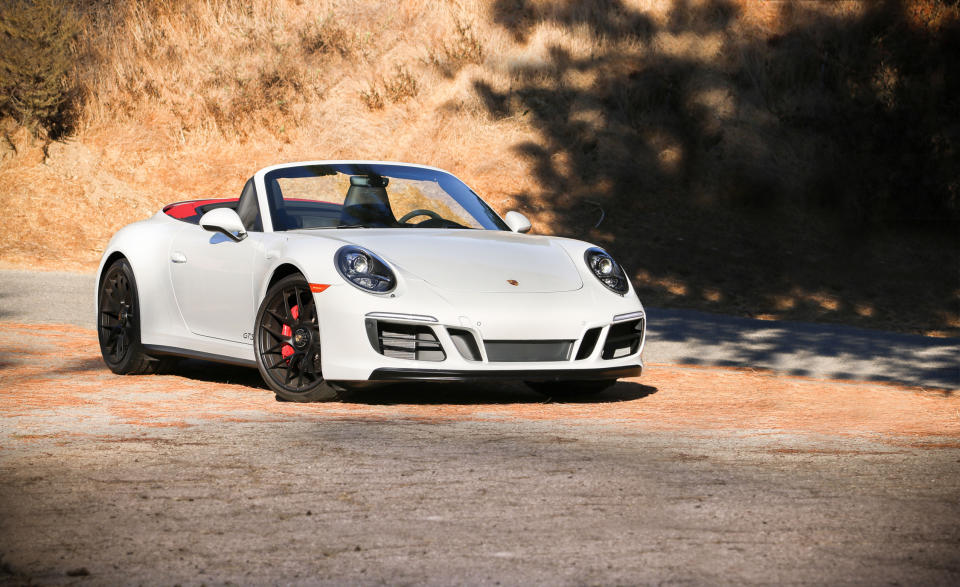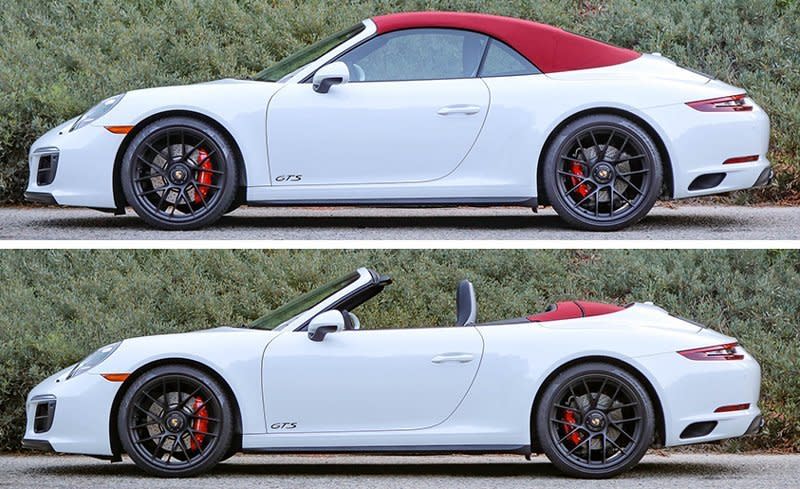2017 Porsche 911 GTS Cabriolet PDK Automatic

The 2017 model year was a big one for the Porsche 911, with the current 991-generation model emerging from its mid-cycle nip/tuck with some light cosmetic touch ups, updated infotainment systems, and, most significant, a new twin-turbocharged 3.0-liter flat-six that’s available in three states of tune—each yielding 20 more horsepower and buckets more torque when compared with the previous models. This move to forced induction for the bread-and-butter models represented the most consequential change to the 911’s magic recipe since the 996-generation model launched in 1999 with water-cooled engines that replaced the maker’s air-cooled masterpieces.
It didn’t take long for the 991’s new engine to win us over, pretty much blowing our minds and leaving us scrambling for superlatives in the seven instrumented tests we’ve already conducted on different configurations of the 370-hp Carrera and the 420-hp Carrera S—the slowest hitting 60 mph in four seconds flat and the quickest doing the deed in just 3.1. Furthermore, each variant demonstrated cornering tenacity to the tune of at least 1.00 g and stopping power from 70 mph in less than 150 feet. But until now, when we strapped our test gear to this white-over-black convertible, we had only gotten our hands on one 450-hp Carrera GTS model, a stick-shift cabriolet. The GTS trim arrived late in the model year wearing its signature blackout garb and offering a full complement of performance features that are extra-cost items on lesser Carreras.

Got Keys, Will Test
Porsche’s dual-clutch automatic transmission (a $3720 option marketed as PDK) commonly produces quicker acceleration times than the equivalent stick-shift model, and this car did not disappoint. In fact, this GTS proved to be the quickest Carrera yet, thanks equally to the snap-shifting PDK and the Sport Chrono package’s quartet of driving modes, two of which (Sport and Sport+) unlock a launch-control sequence that is among the world’s simplest and most brutally effective. From a stop with the stability control switched off, holding the brake with one’s left foot and standing on the gas pedal with the right, the engine shoots to just over 6000 rpm and holds. Releasing the brake sends the 3475-pound ragtop hurtling toward the horizon with explosive force and, remarkably, no wheelspin. Sixty mph arrives in a stupefying 3.0 seconds. Keep it planted and you’ll see 100 mph in just 7.3 seconds and 150 mph in 19 flat, 1.0 and 1.4 seconds sooner than its human-shifted counterpart. Passing is likewise instantaneous, with the 30-to-50- and 50-to-70-mph bursts taking just 2.5 seconds apiece, including the time required for the PDK to downshift. For even quicker passes, a press of the Sport Response button (located in the center of the steering-wheel-mounted driving-mode selector dial) drops the PDK into the perfect gear and primes the throttle in anticipation of just that sort of thing.
G’s, Pulled
Unsurprisingly, the two GTS examples perform similarly in matters not involving shifting. This car’s 1.03 g of maximum grip splits the difference between the other GTS cab’s 1.05 g and the slightly heavier PDK-equipped Carrera S cabriolet’s 1.00 g. Like each of those cars, this one featured the optional ($2090) rear-wheel steering that tightens the turning circle at low speeds while stabilizing the car during high-speed lane changes—both appreciable benefits considering the 911’s combination of a short wheelbase and foot-wide rear tires. Even better, the perfectly weighted steering feel we’ve come to love in every 991.2 remains delightfully organic in the GTS, perhaps even more so with its standard small-diameter GT steering wheel wrapped in nappy faux suede, the same stuff found in the seat inserts and on the lower dash and door panels. And as we discovered during some spirited early-morning romps along Mulholland Drive, it’s not hard to summon some of the GTS’s 405 lb-ft of twist, available as it is from 2150 through 5000 rpm, and make the rear end dance in corners. That said, in Sport+, where the throttle is the most sensitive and the electronannies are the most lenient, it may not take much for your boot-scoot boogie to become a whirling pirouette. This car certainly doesn’t spin as easily as the famously terrifying 930 Turbos of the 1970s and ’80s, but it’s a real possibility for novices or anyone unfamiliar with the cornering physics of a vehicle carrying nearly two-thirds of its mass over the rear axle.

Selecting Sport and Sport+ also brings commensurate adjustments to the standard PASM adaptive dampers, as well as activation of the louder of two modes for the exhaust. Fortunately, the exhaust volume can be adjusted separately via a button on the console in the event that you want to wake up the powertrain without waking up the neighborhood. It gets loud inside the cabin, too, between the engine’s many lovely non-exhaust-related sounds and the considerable road noise from the large tires. It’s sexy noise, of course, but after shutting off the engine following two hours of slogging through rush-hour traffic, silence is a genuine shock to the system.
The ride is quite brittle with the suspension in its firmest setting, although we could drive around all day with the shocks in their medium setting. That said, it’s still a GTS, and bumps do indeed make it into the cabin—a good thing to remember when placing a fancy coffee drink into one of the flimsy cupholders that spring from beneath the 911’s passenger-side trim panel. We can’t imagine the mess that could make inside the GTS hardtop, which rides another 0.4 inch lower with its standard version of the PASM suspension that’s not available on cabriolet and Targa versions.
And, boy, can the GTS stop. At a scant 139 feet, this car turned in the 911’s best 70-mph-to-zero braking performance since a Carrera coupe equipped with PDK posted a stunning 135-foot stop more than a year ago. And with no evidence of fade after many repeated stops nor any loss of its perfect pedal feel, the standard brakes are good enough to render the optional $8520 carbon-ceramic brakes an extravagance for anyone whose last name isn’t Haywood or Röhrl. (Both this GTS and that Carrera coupe were equipped with the standard brakes.)

Make Sure to Earmark Some Money for Interior Dress Up
Indeed, unless one plans to track the thing every weekend, we’d save that money and dress up the interior. The GTS’s cabin may blend traditional analog and high-tech digital elements as harmoniously as every other 991.2, but even with its brushed-metal-like treatment, the black trim used in place of the shiny metallic stuff in lesser Carreras feels surprisingly cheap—a criticism rarely leveled at modern Porsches. Furthermore, the dearth of brightwork or any contrasting hue inside this test car imparts it with all the cheerfulness of a haunted house. Porsche is happy to apply red threading to the seats and the steering wheel for a small fee, and the black tachometer can be swapped out for a red-faced one. Either would help while still remaining stylistically consistent with the GTS’s heritage.
Otherwise, we didn’t learn much that we hadn’t already experienced when scrutinizing the first eight 991.2s. We did find that the GTS’s darkened headlamps, air intakes, and badging really pop against white paint and that a red roof neatly ties together the red brake calipers and the taillamps—even with their smoked lenses—much like the red cap on the silver Carrera 4S Targa we tested last spring. The center-lock 20-inch wheels look just as awesome as they do on the mighty 911 Turbo S, and the GTS-specific satin-black finish sure doesn’t hurt.

Having tested so many different 2017 911s thus far, we were a bit surprised that—even with the $2090 rear-wheel steering, the $3850 black leather and Alcantara interior package, $420 auto-dimming mirrors, and $690 heated front seats—the $143,120 as-tested price of this GTS was nearly $1700 less than the aforementioned rear-drive, PDK-equipped Carrera S cabriolet we tested earlier this year. This underscores the relative value the GTS represents in terms of performance equipment, as its standard sport seats, sport exhaust, PASM adaptive dampers, Sport Chrono package, those sexy 20-inch wheels, and the rest of the GTS’s many driving-enhancement features would send the price of a similarly configured Carrera S thousands of dollars higher—and it’d still have 30 fewer ponies in the stable.
But there are many permutations we have yet to try out, including the quickest Carrera of all, according to Porsche: the GTS hardtop with the PDK transmission. Plus, there are the new GT3 and GT2 RS. So it looks like we’re going to stay busy testing 911s for the foreseeable future, too.
Specifications >
VEHICLE TYPE: rear-engine, rear-wheel-drive, 2+2-passenger, 2-door convertible
PRICE AS TESTED: $143,120 (base price: $136,070)
ENGINE TYPE: twin-turbocharged and intercooled DOHC 24-valve flat-6, aluminum block and heads, direct fuel injection
Displacement: 182 cu in, 2981 cc
Power: 450 hp @ 6500 rpm
Torque: 405 lb-ft @ 2150 rpm
TRANSMISSION: 7-speed dual-clutch automatic with manual shifting mode
DIMENSIONS:
Wheelbase: 96.5 in
Length: 178.3 in
Width: 72.9 in Height: 50.8 in
Passenger volume: 70 cu ft
Cargo volume: 5 cu ft
Curb weight: 3475 lb
C/D TEST RESULTS:
Zero to 60 mph: 3.0 sec
Zero to 100 mph: 7.3 sec
Zero to 130 mph: 13.1 sec
Zero to 150 mph: 19.0 sec
Rolling start, 5–60 mph: 4.0 sec
Top gear, 30–50 mph: 2.5 sec
Top gear, 50–70 mph: 2.5 sec
Standing ¼-mile: 11.3 sec @ 122 mph
Top speed (drag limited, mfr's claim): 192 mph
Braking, 70–0 mph: 139 ft
Roadholding, 300-ft-dia skidpad: 1.03 g
C/D FUEL ECONOMY:
Observed: 16 mpg
EPA FUEL ECONOMY:
Combined/city/highway: 22/20/26 mpg

 Yahoo Finance
Yahoo Finance 